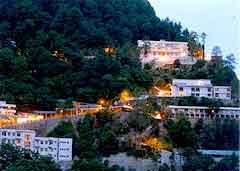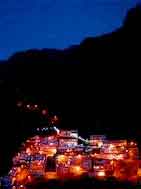|

Reaching Bhavan : A pilgrim can get the
fIrst glimpse of Bhavan around 1.5 kilometers before actually
reaching there by any of the tracks. It brings a sudden
upsurge of energy and all the tiredness of the strenuous climb
evaporate the moment pilgrims get this first glimpse. The
feeling of having almost reached there fills them with extra
fervor and devotion. Upon reaching Bhavan, a pilgrim~ has to get
his Group Number of Darshans after completing the security
check. This group number is allotted at the Yatra Slip Counter
located on the left hand side, immediately after the luggage
Check Post. Other than the free rest rooms, rented dormitory
and self-contained carpeted rooms are available here for
accommodation which requires a prior registration at Enquiry
and Reservation Counter, Katra. One may still try out if any
accommodation is available at Manokamna Bhavan, Gauri Bhavan
and Vaishnavi Bhavan. While Manokamna Bhavan has dormitory
accommodation and hence the possibility of getting a few beds
is higher, Gauri Bhavan and Vaishnavi Bhavan are located
slightly farther from the main Bhavan area and hence on an
average day, one can still get accommodation on the spot.
Types of accommodation include dormitory and self-contained 2
& 4 bedded rooms. Free blankets, cloak rooms, drinking water,
medical facilities, general store, Bhojanalaya,
announcement, telephone, refreshments, etc. facilities are
available at Bhavan.
While waiting for Darshans :
During ordinary days a pilgrim
can enter Gate No.1 and upon crossing the required distance
can reach the Sanctum sanctorum in no time. But on days of
heavy rush, one may have to wait inside the railing or the
waiting room for some time before the queue ahead gets
cleared. The Shrine Board has installed colored television
sets all along the corridors, which relays a direct telecast
of the Holy Pindies. similar television sets are also
installed in various waiting rooms at Bhavan which show
religious and mythological serials and programs. Provision of
urinals and drinking water has also been made in the waiting
corridors.
Procedure of Darshan :
Pilgrims
prefer to take a bath at the Bathing Ghat, with the water that
flows from the feet of Mata. The revelation inside the Holy
Cave is in the form of a natural rock form. The topmost
portion of this rock form has three heads, which are known as
Pindies. The rock on which the Pindies exist is half
immersed in water. Although only" the topmost part of this
rock is visible for Darshans because of the marble platform,
the water that flows touching this Holy Rock form, gushes out
of the Holy Cave and is channeled through pipes at the Bathing
Ghat. Though very cold on any ordinary day, one doesn't feel
its chilling effects.
Pilgrims are required to deposit all their belonging in the
free cloakrooms, if no accommodation is booked at Bhavan, as
nothing except cash and offerings are allowed inside the Holy
Cave. All articles of general use like belts, wrist watches
with leather belts, combs, pen, pencil, purses, handbags, etc.
are prohibited. No sweets are allowed either.
After taking a bath at the Bathing Ghat or elsewhere,
pilgrims can reach Gate No.1 where upon announcement (and/or
display on the display board) of the group number, they are
allowed inside the railing which leads them to one of the
greatest moment of their lives, a Darshan of the Divine Mother
inside the Holy Cave in the natural rock form i.e. the Holy
Pindies.
The Original Cave and
the New Tunnel : While
on the way to the Sanctum Sanctorum, one crosses a small patio
type of structure where on the right hand side is a cave
opening. This is the original cave leading to the Holy Pindies,
which is kept closed now for a fair part of the year. Because
of being narrow, it takes several minutes for a person to
cross it and reach the Sanctum Sanctorum and considering the
rush that the Holy Shrine witnesses normally, it is not
possible to keep it open except when the Yatra is less than
8000 pilgrims per day. Hence two new tunnels have been
constructed to facilitate more number of pilgrims to have the
Darshans. One tunnel is used for the entrance, which leads
directly to the Sanctum Sanctorum. The other tunnel is used
for exit.
Only during winters and lean Yatra periods when the number
of pilgrims visiting the Holy Shrine is at their minimum, is
the original cave opened for Darshans. Passing through this
cave is a .different experience altogether.

Darshans
:
When
one crosses the portion where the original Cave is located,
one walks further through a corridor on which numerous bells
suspend from the ceiling. After walking a few yards, one
reaches a broad platform where few statues of Lions, mount of
the Mother Goddess and Her life size statue are kept. From
here starts the new tunnel.
Upon entering the tunnel, one should observe silence and
carefully move in the queue concentrating towards the left
hand side where at the end of the tunnel is a raised marble
platform on which the Divine Mother has revealed Herself in a
natural rock form known as the Holy Pindies. Pilgrims should
refrain from shouting slogans of praises inside the tunnel and
around Sanctum Sanctorum as it disturbs other pilgrims who may
be interested in concentrating on Darshans and the description
given by the priests.
The complete rock structure is covered under a white marble
platform and only the topmost portion is visible for Darshans.
These are three Pindies, denoting the three Supreme Energies
of Creation, Maintenance and Dissolution. Towards the left of
the viewer is the Holy Pindi of Mata Maha Saraswati, the
Supreme Energy of Creation. It has a visible white tinge over
it, the color associated with Mata Maha Saraswati. In the
middle is the Holy Pindi of Mata Maha Lakshmi, the Supreme
Energy of Maintenance, with a distinct yellow-reddish tinge,
the color associated with Mata Maha Lakshmi and towards
extreme right is the Pindi of Mata Maha Kali, the Supreme
Energy of Dissolution, black in color, the color associated
with Mata Maha Kali.
The image of the main Darshans
inside the Holy Cave has
also been reproduced on the inside of the cover page. The
priest sitting on the Platform, informs the pilgrim about
these Pindies, however since the time of Darshans is very
less, one only gets a glimpse of the Holy Pindies and has to
move further, in order to keep the queue moving.
Other Darshans inside the Holy Cave : The
Holy Cave is around 98 feet long. There/are various other II
symbolic Darshans, outside and inside the Holy Cave and around the Holy Pindies. It is believed that the Darshans of
33 crore (330 million) Gods and Goddesses are present in the
Holy Cave and that at some given point of time, each of them
have worshipped the Mother Goddess in this cave and have left
their symbolic marks inside. It is also believed that during
Poojan and Aarti in the morning and evening, all these Gods
and Goddesses arrive at the Holy Cave to pay their obeisance
to the Mother.
At the entry of the Holy Cave, towards the left hand side,
is the symbol of Vakra Tund Ganesh. Adjacent to the symbol of
Lord Ganesh are the symbols of Surra and Chandra Dev. When one
enters the Holy Cave, one crosses over the Dadh (torso) of
Bhairon Nath, which is around 14 feet long. Due to the impact
of the mighty blow of the Divine Mother, while the head of
Bhairon Nath fell atop an adjacent mountain a couple of
kilometers away from the Holy Cave, his body lay lifeless at
the entrance of the Holy Cave.
After the Dadh of the Bhairon is the symbol of Lord
Hanurnan known as Launkra Beer. Then comes Charan Ganga,
flowing from the feet of Mata and pilgrims have to wade
through water beyond this point. Around 23 feet beyond Launkra
Beer, on the left upper hand side, the roof of the cave flares
out and the entire weight of this cave appears to rest on the
innumerable heads of Shesh Nag. Immediately below Shesh Nag is
the Havan Kund of Mata and adjacent to it are the symbols of
Shankh, Chakra, Gada and Padam.
Above, almost touching the ceiling of the cave are the
symbols of five Pandavs, Sapt Rishis, Than (breast) of
the divine' cow Kamdhenu, symbols of Brahma-Vishnu-Mahesh and
Shiv-Parvati. 3 feet further ahead, on an elevation can be
seen the Khamba that was gripped by the legendary worshipper
Prahlad. Diagonally below this, at the water level is the
Yantra with innumerable mystical signs and symbols inscribed
on it. 22 feet beyond this point is located the Sher Ka Panja,
symbolizing the lion which is the mount of the Mata Vaishno
Devi Ii. The distance from the entry point to the Sher Ka
Panja is 59 feet. 13 feet beyond this, redone in pure gold in
which more than 52 kilograms of gold and many diamonds and
precious stones were used. The platform around the Holy
Pindies and the patio type structure just outside the Holy
Cave, popularly known as Atka were also renovated with
white marble. The work was completed on 31st January, 2001 and
after Poojan and Havan, the items of the ornamentation were
presented at the lotus feet of the Divine Mother.
|
